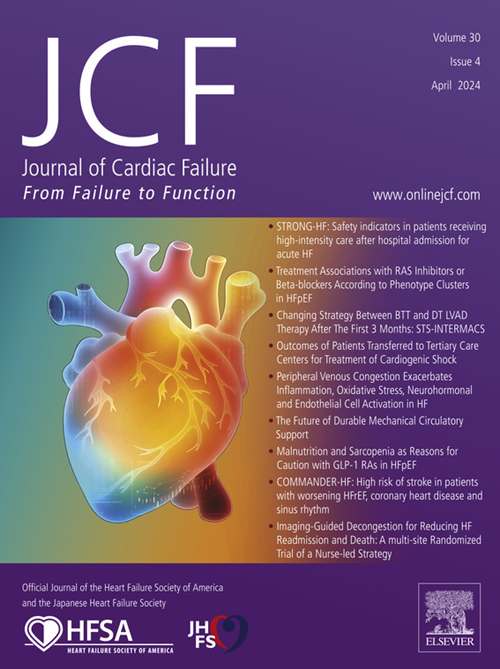Facilitators and Barriers to Values Discussions Following LVAD Implantation: Perspectives from Diverse Patients and Family Caregivers
IF 8.2
2区 医学
Q1 CARDIAC & CARDIOVASCULAR SYSTEMS
引用次数: 0
Abstract
Background
Delivering care that is responsive to who or what is most important to patients and family caregivers is a key aspect of quality care, yet it remains unclear how clinicians can best support individuals in expressing their personal values. We aimed to describe patient- and family caregiver–identified facilitators and barriers to engaging in values discussions with clinicians following implantation of a left ventricular assist device (LVAD).
Methods and results
Using a qualitative descriptive approach, patients with an LVAD and their caregivers participated in 1-on-1 semistructured interviews and self-reported sociodemographics (January 2023–July 2023). Qualitative data were analyzed using thematic analysis and descriptive statistics were computed for quantitative data.
Results
Patients (n = 27; ages 30–76 years) were predominantly male (59%) and non-Hispanic Black (67%). Caregivers (n = 21; ages 27–76) were female (76%), non-Hispanic Black (67%), and a spouse/partner (62%). Facilitators (5 shared across patient/caregiver groups; 8 unique across patient/caregiver groups) included a perceived close relationship (patient/caregiver), values alignment (patient/caregiver), clinician discussion initiation (patient/caregiver), facing an impending decision (patient/caregiver), 1-on-1 dyadic interactions (patient/caregiver), being assertive (patient), positive dyadic communication (caregiver), and involvement of a third party (caregiver). Barriers (2 shared; 7 unique) included belief that their values are already known (patient/caregiver), sensitivity about values (patient/caregiver), uncertainty about timing (patient), poor clinical communication (patient), patient hopelessness (patient), perceived lack of clinician time (caregiver), and having a reserved personality (caregiver).
Conclusion
Findings offer insight into actionable facilitators and barriers to discussions promoting incorporation of patient and family values into LVAD maintenance and chronic disease management.
LVAD植入后价值讨论的促进因素和障碍:来自不同患者和家庭照顾者的观点。
提供对患者和家庭照顾者最重要的人或什么最重要的护理是优质护理的一个关键方面,但临床医生如何最好地支持个人表达他们的个人价值观仍不清楚。我们的目的是描述患者和家属在植入左心室辅助装置(LVAD)后与临床医生进行价值讨论时确定的促进因素和障碍。方法和结果采用定性描述方法,LVAD患者及其护理人员参与了一对一的半结构化访谈和自我报告的社会人口统计学(2023年1月至2023年7月)。定性数据采用专题分析,定量数据采用描述性统计。结果患者(n=27;年龄30-76岁)主要为男性(59%)和非西班牙裔黑人(67%)。照顾者(n = 21;年龄27-76岁)为女性(76%)、非西班牙裔黑人(67%)和配偶/伴侣(62%)。促进者(5名)在患者/护理人员群体中共享;包括感知到的亲密关系(患者/护理人员)、价值观一致性(患者/护理人员)、临床医生讨论启动(患者/护理人员)、面临即将做出的决定(患者/护理人员)、1对1的二元互动(患者/护理人员)、自信(患者)、积极的二元沟通(护理人员)和第三方(护理人员)的参与。障碍(2个共享;包括相信他们的价值观是已知的(患者/护理者),对价值观敏感(患者/护理者),对时机的不确定(患者),临床沟通不良(患者),患者绝望(患者),缺乏临床医生时间(护理者),性格保守(护理者)。结论:研究结果为促进将患者和家庭价值观纳入LVAD维持和慢性疾病管理的讨论提供了可操作的促进因素和障碍。
本文章由计算机程序翻译,如有差异,请以英文原文为准。
求助全文
约1分钟内获得全文
求助全文
来源期刊

Journal of Cardiac Failure
医学-心血管系统
CiteScore
7.80
自引率
8.30%
发文量
653
审稿时长
21 days
期刊介绍:
Journal of Cardiac Failure publishes original, peer-reviewed communications of scientific excellence and review articles on clinical research, basic human studies, animal studies, and bench research with potential clinical applications to heart failure - pathogenesis, etiology, epidemiology, pathophysiological mechanisms, assessment, prevention, and treatment.
 求助内容:
求助内容: 应助结果提醒方式:
应助结果提醒方式:


